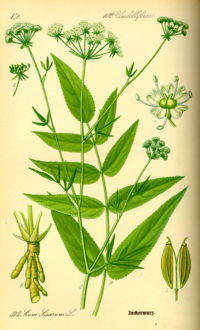Skirret: Difference between revisions
No edit summary |
No edit summary |
||
| Line 1: | Line 1: | ||
{{Inc| | |||
Skirret (Sium Sisarum, Linn.) is a vegetable of minor importance, the roots of which are used like salsify or oyster plant. It is a hardy perennial umbelliferous herb, native to eastern Asia. It grows 3 to 4 feet high, has pinnate foliage and small white flowers in compound umbels. The roots grow in large clusters, something like those of a sweet potato or dahlia, but they are much longer, more cylindrical, and somewhat jointed. The roots have a sweet and slightly floury taste and, if well grown, are tender. The chief objection to this vegetable is the woody core, which must be removed before cooking, as it is not easily separated from the fleshy part at the table and detracts from its quality. The thickness of the core varies greatly, no matter whether the plants are propagated by seed or otherwise. | |||
Skirret needs a rich soil. The seeds may be sown in autumn or spring and the plants yield well the first season. For European practice Vilmorin recommends that the seedlings be grown in a seed-bed until they have made four or five leaves and then transplanted into permanent quarters. Sow the seed in drills 1/2 inch deep, and thin out the seedlings to 8 inches in the row. The roots may be left outdoors in the ground all winter, but others advise storing them in sand or earth. | |||
}} | |||
{{Taxobox | {{Taxobox | ||
| color = lightgreen | | color = lightgreen | ||
Revision as of 17:21, 6 July 2009
| Standard Cyclopedia of Horticulture |
|---|
|
Skirret (Sium Sisarum, Linn.) is a vegetable of minor importance, the roots of which are used like salsify or oyster plant. It is a hardy perennial umbelliferous herb, native to eastern Asia. It grows 3 to 4 feet high, has pinnate foliage and small white flowers in compound umbels. The roots grow in large clusters, something like those of a sweet potato or dahlia, but they are much longer, more cylindrical, and somewhat jointed. The roots have a sweet and slightly floury taste and, if well grown, are tender. The chief objection to this vegetable is the woody core, which must be removed before cooking, as it is not easily separated from the fleshy part at the table and detracts from its quality. The thickness of the core varies greatly, no matter whether the plants are propagated by seed or otherwise. Skirret needs a rich soil. The seeds may be sown in autumn or spring and the plants yield well the first season. For European practice Vilmorin recommends that the seedlings be grown in a seed-bed until they have made four or five leaves and then transplanted into permanent quarters. Sow the seed in drills 1/2 inch deep, and thin out the seedlings to 8 inches in the row. The roots may be left outdoors in the ground all winter, but others advise storing them in sand or earth.
|
| Sium sisarum {{{status}}} Fossil range: {{{fossil_range}}}
| ||||||||||||||||||||||||||||||||||||||||||||||||||||||||||||||||||
|---|---|---|---|---|---|---|---|---|---|---|---|---|---|---|---|---|---|---|---|---|---|---|---|---|---|---|---|---|---|---|---|---|---|---|---|---|---|---|---|---|---|---|---|---|---|---|---|---|---|---|---|---|---|---|---|---|---|---|---|---|---|---|---|---|---|---|
 | ||||||||||||||||||||||||||||||||||||||||||||||||||||||||||||||||||
| Plant Info | ||||||||||||||||||||||||||||||||||||||||||||||||||||||||||||||||||
| ||||||||||||||||||||||||||||||||||||||||||||||||||||||||||||||||||
| Scientific classification | ||||||||||||||||||||||||||||||||||||||||||||||||||||||||||||||||||
| ||||||||||||||||||||||||||||||||||||||||||||||||||||||||||||||||||
| [[{{{diversity_link}}}|Diversity]] | ||||||||||||||||||||||||||||||||||||||||||||||||||||||||||||||||||
| {{{diversity}}} | ||||||||||||||||||||||||||||||||||||||||||||||||||||||||||||||||||
| Binomial name | ||||||||||||||||||||||||||||||||||||||||||||||||||||||||||||||||||
| Sium sisarum L. | ||||||||||||||||||||||||||||||||||||||||||||||||||||||||||||||||||
| Trinomial name | ||||||||||||||||||||||||||||||||||||||||||||||||||||||||||||||||||
| {{{trinomial}}} | ||||||||||||||||||||||||||||||||||||||||||||||||||||||||||||||||||
| Type Species | ||||||||||||||||||||||||||||||||||||||||||||||||||||||||||||||||||
| {{{type_species}}} | ||||||||||||||||||||||||||||||||||||||||||||||||||||||||||||||||||
| {{{subdivision_ranks}}} | ||||||||||||||||||||||||||||||||||||||||||||||||||||||||||||||||||
| [[Image:{{{range_map}}}|{{{range_map_width}}}|]] | ||||||||||||||||||||||||||||||||||||||||||||||||||||||||||||||||||
| Synonyms | ||||||||||||||||||||||||||||||||||||||||||||||||||||||||||||||||||
| {{{synonyms}}} |
Sium sisarum or skirret is a perennial plant of the family Apiaceae sometimes grown as a root vegetable. It has a cluster of sweet, bright white roots which are similar to sweet potatoes, but longer (15-20 cm). Skirrets may be boiled, stewed, or roasted. The woody core is inedible, and should be removed before cooking because it is difficult to remove after.
The skirret is of Chinese origin, but may have arrived in Europe in early times: it is presumed to be the siser mentioned by Pliny the Elder as a favourite of the Emperor Tiberius (Natural History, 19.27.90).
The plant grows about 1 m high and is very resistant to cold, as well as pests and diseases. It is usually grown from seeds, but may also be started from root divisions. Lack of moisture makes the root more fibrous.